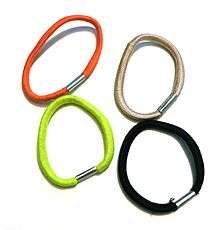Hair tie
A ponytail holder (also called a hair tie, hair band, hair elastic, wrap around, gogo or bobble) is an item used to fasten hair, particularly long hair, away from areas such as the face. This is usually done as part of a hairstyle such as pigtails, bunches, or ponytails for straight, wavy and loosely curled hair, and referred to as afro puffs, bunny tails and "pineapples" for highly curled and highly textured natural hair. Two common types of ponytail holders are the scrunchie[1] and the elastic. The term can also include a fixed tie which is placed through strands to hold specific parts of hair together, rather than tie it or clasp together like a hair clip.


Ponytail holders' elasticity and durability vary according to the material or materials from which they are made.
History
The use of hair ties, in one form or another, is likely to have stretched for thousands of years, as the primary reason (controlling hair disrupting daily activities) would have existed from an early point. This would have had to take place by whatever means were possible, with bands of leather a likely early option.[2] Alternatives included entwined threads of different fabrics, or entwined pegs, with one 1500 year old example including gold in its creation.[3] Brighter and rarer coloured ribbons were usually preferred by girls.[2]
In the 18th century wigs used a "queue" or "tail", consisting of a leather strap or small bag, to hold the wig together and support it.[2][4]
The early to mid 19th century and the modernisation of a rubber industry[5] allowed for use of rubber in clothing, which would ultimately include early elastic hair ties.[2] While providing some of the benefits of modern ties, being flexible in size and self-closing, rubber ties could catch on individual hair strands, pull on them, remove them from the scalp and ultimately cause loss of hair.[2][6]
Other names for hair ties
Hair ties are known by numerous names. Among the more common are:
|
|
See also
References
- Bindley, Katherine (2018-03-20). "Scrunchies, Scourge of the 1980s, Are Back". Wall Street Journal. ISSN 0099-9660. Retrieved 2018-08-22.
- "The History of Hair Ties". leaf. Retrieved 23 August 2018.
- J. V. Bellezza (2014). The dawn of Tibet : the ancient civilization on the roof of the world. Rowman and Littlefield. OCLC 890146515.
- A. Lowery (2013). Historical Wig Styling: Ancient Egypt to the 1830s. Taylor and Francis. ISBN 9780240821238. Retrieved 23 August 2018.
- Charles Slack (2002). Noble obsession : Charles Goodyear, Thomas Hancock, and the race to unlock the greatest industrial secret of the nineteenth century. Hyperion. OCLC 49942707.
- Marilisa Racco (9 March 2018). "5 reasons why your hair is breaking and how to fix it". Global News. Retrieved 23 August 2018.